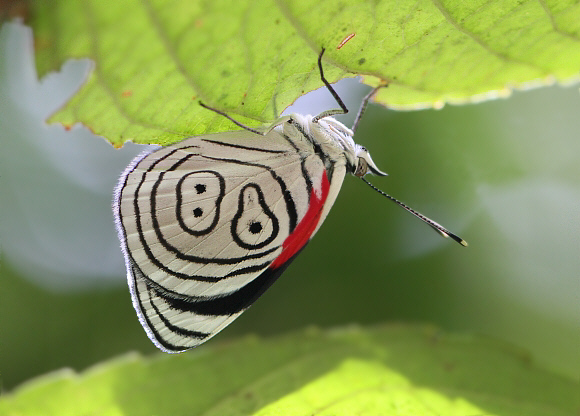 Diaethria euclides phlogeides, Tatama NP, Colombia – Adrian Hoskins
Diaethria euclides phlogeides, Tatama NP, Colombia – Adrian Hoskins
Introduction
The genus Diaethria is confined to Central and South America – 3 species are found in Mexico while the remainder are widely distributed across the Amazon and Andes.
The uppersides of all Diaethria species are black, marked on the forewings with a diagonal band of metallic blue or green. In some species this colour is repeated on the hindwings in the form of a submarginal band.
The 89 or 88 numerals which appear on the underside hindwings of euclides are present in all 12 of the Diaethria species but vary in colour, thickness and shape. In clymena for example the lines are quite thick, and the markings often form an ’88’ figure, while in others such as neglecta and euclides they are thin and form an ’89’. Diaethria euclides can be recognised by the red edging to the under-side costa, which extends only as far as the innermost of the black submarginal lines. In most other species e.g. neglecta, clymena and gabaza it reaches the outermost line. In some examples of euclides the ‘9’ numeral is confluent with the innermost line.
Diaethria euclides occurs in Colombia, Venezuela, Ecuador and northern Peru. There are 6 named subspecies. The illustrated subspecies phlogeides is endemic to Colombia.
 Diaethria euclides phlogeides, Tatama NP, Colombia – Adrian Hoskins
Diaethria euclides phlogeides, Tatama NP, Colombia – Adrian Hoskins
Habitats
This species occurs in cloudforest at elevations between about 1000-2000m.
Lifecycle
The eggs in common with those of other Diaethria species are whitish and highly sculptured. They are laid singly on the underside of leaves of Ulmaceae, close to the midrib. The larva is green, with a slightly roughened texture, and bears a pair of short spikes on the anal segment. The head bears a pair of very long whorled spines. The larva habitually rests on the upper surface of a leaf, with the thoracic segments raised and the head appressed to the substrate, causing the spines to project upward. If molested the larva twitches violently, swinging its head defensively from side to side to scare away predators or parasitoids. The chrysalis is suspended by the cremaster from a leaf or stem. It is green, with a dorsal keel, and projecting palpi.
Adult behaviour
Both sexes are attracted to rotting fruit. The males are strongly attracted to urine-soaked sand, and also imbibe dissolved minerals from damp soil, road surfaces and rock faces. They are very active butterflies, easily disturbed, and rarely settle for more than a few seconds at a time in one spot, but they will return repeatedly to the same patch of ground.
When not feeding, males perch on the upper surface of leaves at a height of about 2-3m, awaiting passing females. They also commonly perch facing head-downwards, on walls or tree trunks.

Diaethria euclides phlogeides, Tatama NP, Colombia – Adrian Hoskins
